Spatiotemporal Variability and Driving Factors of Vegetation Net Primary Productivity in the Yellow River Basin (Shaanxi Section) from 2000 to 2022
Abstract
1. Introduction
2. Materials and Methods
2.1. Study Area
2.2. Data Source
3. Method
3.1. Analysis of NPP Change Trends
3.2. Significance Test of NPP Changes
3.3. Analysis of Spatial Variability of NPP
3.4. Analysis of NPP Gravity Center Shift Patterns
3.5. Analysis of Driving Factors for Spatial Variations of NPP
4. Results
4.1. Spatiotemporal Change Analysis of NPP
4.1.1. Interannual Variation of NPP
4.1.2. Spatial Variation of NPP
4.2. Trend of NPP Changes in the Study Area
4.2.1. Spatial Stability of NPP
4.2.2. NPP Gravity Center Dynamics
4.2.3. The Trend of NPP Changes
4.3. Spatial Drivers and Interactions on NPP
4.3.1. Driving Factors for Spatial Variations of NPP
4.3.2. Interaction Detection Analysis
5. Discussion
5.1. Overall Variations and Spatial Differences in NPP
5.2. Patterns of NPP Gravity Center Shifts
5.3. Analysis of Driving Mechanisms
6. Conclusions
Author Contributions
Funding
Institutional Review Board Statement
Informed Consent Statement
Data Availability Statement
Conflicts of Interest
References
- Running, S.W.; Thornton, P.E.; Nemani, R.; Glassy, J.M. Global terrestrial gross and net primary productivity from the earth observing system. In Methods in Ecosystem Science; Springer: Berlin/Heidelberg, Germany, 2000; pp. 44–57. [Google Scholar]
- Cao, M.; Woodward, F.I. Dynamic responses of terrestrial ecosystem carbon cycling to global climate change. Nature 1998, 393, 249–252. [Google Scholar] [CrossRef]
- Fang, J.; Chen, A.; Peng, C.; Zhao, S.; Ci, L. Changes in forest biomass carbon storage in China between 1949 and 1998. Science 2001, 292, 2320–2322. [Google Scholar] [CrossRef]
- Carlson, T.N.; Ripley, D.A. On the relation between NDVI, fractional vegetation cover, and leaf area index. Remote Sens. Environ. 1997, 62, 241–252. [Google Scholar] [CrossRef]
- Bolinder, M.A.; Janzen, H.H.; Gregorich, E.G.; Angers, D.A.; Vandenbygaart, A.J. An approach for estimating net primary productivity and annual carbon inputs to soil for common agricultural crops in Canada. Agric. Ecosyst. Environ. 2007, 118, 29–42. [Google Scholar] [CrossRef]
- Cleveland, C.C.; Townsend, A.R.; Taylor, P.; Alvarez-Clare, S.; Bustamante, M.M.; Chuyong, G.; Dobrowski, S.Z.; Grierson, P.; Harms, K.E.; Houlton, B.Z. Relationships among net primary productivity, nutrients and climate in tropical rain forest: A pan-tropical analysis. Ecol. Lett. 2011, 14, 939–947. [Google Scholar] [CrossRef] [PubMed]
- van Breemen, N. Soils as biotic constructs favouring net primary productivity. Geoderma 1993, 57, 183–211. [Google Scholar] [CrossRef]
- Ren, L.; Zhao, W.; Li, J.; Chen, J.; Li, Y.; Zou, H.; Zhang, Y. Characteristics of soil CO2 emission and carbon balance in greenhouse soil under different fertilization patterns. Chin. J. Soil Sci. 2022, 53, 874881. [Google Scholar]
- Running, S.W.; Coughlan, J.C. A general model of forest ecosystem processes for regional applications I. Hydrologic balance, canopy gas exchange and primary production processes. Ecol. Model. 1988, 42, 125–154. [Google Scholar] [CrossRef]
- Field, C.B.; Randerson, J.T.; Malmström, C.M. Global net primary production: Combining ecology and remote sensing. Remote Sens. Environ. 1995, 51, 74–88. [Google Scholar] [CrossRef]
- Tagesson, T.; Smith, B.; Lfgren, A.; Rammig, A.; Lindroth, E.A. Estimating Net Primary Production of Swedish Forest Landscapes by Combining Mechanistic Modeling and Remote Sensing. Ambio 2009, 38, 316–324. [Google Scholar] [CrossRef]
- Wang, S.; Mo, X. Comparison of multiple models for estimating gross primary production using remote sensing data and fluxnet observations. Remote Sens. GIS Hydrol. Water Resour. 2015, 368, 75–80. [Google Scholar] [CrossRef]
- Zhao, M.; Running, S.W. Drought-induced reduction in global terrestrial net primary production from 2000 through 2009. Science 2010, 329, 940–943. [Google Scholar] [CrossRef] [PubMed]
- Qiao, B.; Cao, X.; Sun, W.; Gao, Y.; Chen, Q.; Yu, H.; Wang, Z.; Wang, N.a.; Cheng, H.; Wang, Y. Ecological zoning identification and optimization strategies based on ecosystem service value and landscape ecological risk: Taking Qinghai area of QilianM ountain National Park as an example. Acta Ecol. Sin. 2023, 43, 986–1004. [Google Scholar]
- Hou, J.; Li, M.; Mao, X.; Hao, Y.; Liu, H. Response of microbial community of organic-matter-impoverished arable soil to long-term application of soil conditioner derived from dynamic rapid fermentation of food waste. PLoS ONE 2017, 12, e0175715. [Google Scholar] [CrossRef]
- Jenkinson, D.; Adams, D.; Wild, A. Model estimates of CO2 emissions from soil in response to global warming. Nature 1991, 351, 304–306. [Google Scholar] [CrossRef]
- He, H.; MaB, X. Spatiotemporal changes of NPP and Natural factors in the Southwestern karst areas from 2000 to 2019. Res. Soil Water Conserv. 2022, 29, 172–178, 188. [Google Scholar]
- Ji, Y.; Zhou, G.; Luo, T.; Dan, Y.; Zhou, L.; Lv, X. Variation of net primary productivity and its drivers in China’s forests during 2000–2018. For. Ecosyst. 2020, 7, 15. [Google Scholar] [CrossRef]
- Ren, H.; Shang, Y.; Zhang, S. Measuring the spatiotemporal variations of vegetation net primary productivity in Inner Mongolia using spatial autocorrelation. Ecol. Indic. 2020, 112, 106108. [Google Scholar] [CrossRef]
- Wei, J.; Yaning, C.; Weihong, L.I.; Chenggang, Z.; Zhi, L.I. Estimation of net primary productivity and its driving factors in the Ili River Valley, China. J. Arid. Land 2018, 10, 781–793. [Google Scholar] [CrossRef]
- ZHU, Y.-y.; HAN, L.; ZHAO, Y.-h.; AO, Y.; LI, J.-j.; XU, K.-b.; LIU, B.; GE, Y.-y. Simulation and spatio-temporal pattern of vegetation NPP in northwest China. Chin. J. Ecol. 2019, 38, 1861. [Google Scholar]
- Chen, Y.; Li, Y.; Wang, X.; Yao, C.; Niu, Y. Risk and countermeasures of global change in ecologically vulnerable regions of China. J. Desert Res. 2022, 42, 148. [Google Scholar]
- Zhang, Z.; Pan, H.; Liu, Y.; Sheng, S. Ecosystem services’ response to land use intensity: A case study of the Hilly and Gully Region in China’s Loess Plateau. Land 2024, 13, 2039. [Google Scholar] [CrossRef]
- Xiao, T.; Wang, J.B.; Chen, Z.Q. Vulnerability of Grassland Ecosystems in the Sanjiangyuan Region Based on NPP. Resour. Sci. 2010, 32, 323–330. [Google Scholar]
- Chen, X.; Bai, J.; Li, X.; Luo, G.; Li, J.; Li, B.L. Changes in land use/land cover and ecosystem services in Central Asia during 1990–2009. Curr. Opin. Environ. Sustain. 2013, 5, 116–127. [Google Scholar] [CrossRef]
- Shi, W.Y.; Chen, Y.Z.; Feng, X.M. Identifying the terrestrial carbon benefits from ecosystem restoration in ecologically fragile regions. Agric. Ecosyst. Environ. 2020, 296, 106889. [Google Scholar] [CrossRef]
- Bai, X.; Zhang, Z.; Li, Z.; Zhang, J. Spatial heterogeneity and formation mechanism of eco-environmental quality in the Yellow River Basin. Sustainability 2023, 15, 10878. [Google Scholar] [CrossRef]
- Yong, X.; Chuansheng, W. Ecological protection and high-quality development in the Yellow River Basin: Framework, path, and countermeasure. Bull. Chin. Acad. Sci. (Chin. Version) 2020, 35, 875–883. [Google Scholar]
- Zhang, J.; Liu, Y.; Liu, C.; Guo, S.; Cui, J. Study on the spatial and temporal evolution of high-quality development in nine provinces of the Yellow River Basin. Sustainability 2023, 15, 6975. [Google Scholar] [CrossRef]
- Zhang, Z.; Wang, S.; Zhang, J. Spatiotemporal evolution of carbon budget and carbon compensation zoning of urban agglomerations in the Yellow River Basin. Sci. Rep. 2024, 14, 17984. [Google Scholar] [CrossRef] [PubMed]
- Wang, S.; Fu, B.; Piao, S.; Lü, Y.; Ciais, P.; Feng, X.; Wang, Y. Reduced sediment transport in the Yellow River due to anthropogenic changes. Nat. Geosci. 2016, 9, 38–41. [Google Scholar] [CrossRef]
- Fu, B.; Wang, S.; Liu, Y.; Liu, J.; Liang, W.; Miao, C. Hydrogeomorphic ecosystem responses to natural and anthropogenic changes in the Loess Plateau of China. Annu. Rev. Earth Planet. Sci. 2017, 45, 223–243. [Google Scholar] [CrossRef]
- Xuan, W.; Rao, L. Spatiotemporal dynamics of net primary productivity and its influencing factors in the middle reaches of the Yellow River from 2000 to 2020. Front. Plant Sci. 2023, 14, 1043807. [Google Scholar] [CrossRef]
- Lin, Z.; Liu, Y.; Wen, Z.; Chen, X.; Han, P.; Zheng, C.; Yao, H.; Wang, Z.; Shi, H. Spatial–temporal variation characteristics and driving factors of net primary production in the Yellow River Basin over multiple time scales. Remote Sens. 2023, 15, 5273. [Google Scholar] [CrossRef]
- Li, H.; He, Y.; Zhang, L.; Cao, S.; Sun, Q. Spatiotemporal changes of Gross Primary Production in the Yellow River Basin of China under the influence of climate-driven and human-activity. Glob. Ecol. Conserv. 2023, 46, e02550. [Google Scholar] [CrossRef]
- Zhang, F.; Hu, X.; Zhang, J.; Li, C.; Zhang, Y.; Li, X. Change in Alpine Grassland NPP in response to climate variation and human activities in the Yellow River Source Zone from 2000 to 2020. Sustainability 2022, 14, 8790. [Google Scholar] [CrossRef]
- Zhang, X.; Xiao, W.; Wang, Y.; Wang, Y.; Wang, H.; Wang, Y.; Zhu, L.; Yang, R. Spatial-temporal changes in NPP and its relationship with climate factors based on sensitivity analysis in the Shiyang River Basin. J. Earth Syst. Sci. 2020, 129, 24. [Google Scholar] [CrossRef]
- Yang, Z.P.; Gao, J.X.; Tian, M.R. Spatial and Temporal Patterns of Net Primary Productivity in the Source Regions of Yangtze and Yellow Rivers. Adv. Mater. Res. 2012, 518–523, 5130–5137. [Google Scholar] [CrossRef]
- Lyu, J.; Fu, X.; Lu, C.; Zhang, Y.; Luo, P.; Guo, P.; Huo, A.; Zhou, M. Quantitative assessment of spatiotemporal dynamics in vegetation NPP, NEP and carbon sink capacity in the Weihe River Basin from 2001 to 2020. J. Clean. Prod. 2023, 428, 139384. [Google Scholar] [CrossRef]
- Rui, S.; Yuyu, Z.; Changming, L.; Shiqi, Y. Response of net primary productivity on climate change in the Yellow River basin. In Proceedings of the IGARSS 2003. 2003 IEEE International Geoscience and Remote Sensing Symposium. Proceedings (IEEE Cat. No. 03CH37477), Toulouse, France, 21–25 July 2003; pp. 3371–3373. [Google Scholar]
- Guo, R.; Tian, J.; Yang, Z.; Yang, Z.; Wenrui, S.U.; Liu, W. Spatio-temporal variation characteristics of forest net primary productivity in the Yellow River Basin based on Google Earth Engine cloud platform. Acta Ecol. Sin. 2022, 42, 5437–5445. [Google Scholar] [CrossRef]
- Xie, B.; Qin, Z.; Wang, Y.; Chang, Q. Spatial and temporal variation in terrestrial net primary productivity on Chinese Loess Plateau and its influential factors. Trans. Chin. Soc. Agric. Eng. (Trans. CSAE) 2014, 30, 244–253. [Google Scholar]
- Tian, K.; Liu, X.; Zhang, B.; Wang, Z.; Xu, G.; Chang, K.; Xu, P.; Han, B. Analysis of Spatiotemporal Evolution and Influencing Factors of Vegetation Net Primary Productivity in the Yellow River Basin from 2000 to 2022. Sustainability 2023, 16. [Google Scholar] [CrossRef]
- Yang, M.; Xue, L.; Liu, Y.; Liu, S.; Han, Q.; Yang, L.; Chi, Y. Asymmetric response of vegetation GPP to impervious surface expansion: Case studies in the Yellow and Yangtze River Basins. Environ. Res. 2023, 243, 117813. [Google Scholar] [CrossRef] [PubMed]
- Tian, Z.; Qin, T.; Wang, H.; Li, Y.; Yan, S.; Hou, J.; Li, C.; Abebe, S.A. Delayed response of net primary productivity with climate change in the Yiluo River basin. Front. Earth Sci. 2023, 10, 1017819. [Google Scholar] [CrossRef]
- Cao, Y.; Xie, Z.; Huang, X.; Cui, M.; Wang, W.; Li, Q. Vegetation dynamics and its trends associated with extreme climate events in the Yellow River Basin, China. Remote Sens. 2023, 15, 4683. [Google Scholar] [CrossRef]
- Liu, Z.; Wang, D.; Han, L.; Kang, H.; Cao, X. Vegetation Quality Assessment of the Shaanxi Section of the Yellow River Basin Based on NDVI and Rain-Use Efficiency. Land 2025, 14, 166. [Google Scholar] [CrossRef]
- Xin, Z.; Xu, J.; Zheng, W. Spatiotemporal variations of vegetation cover on the Chinese Loess Plateau (1981–2006): Impacts of climate changes and human activities. Sci. China Ser. D Earth Sci. 2008, 51, 67–78. [Google Scholar] [CrossRef]
- Sun, W.; Song, X.; Mu, X.; Gao, P.; Wang, F.; Zhao, G. Spatiotemporal vegetation cover variations associated with climate change and ecological restoration in the Loess Plateau. Agric. For. Meteorol. 2015, 209, 87–99. [Google Scholar] [CrossRef]
- Ge, W.; Deng, L.; Wang, F.; Han, J. Quantifying the contributions of human activities and climate change to vegetation net primary productivity dynamics in China from 2001 to 2016. Sci. Total Environ. 2021, 773, 145648. [Google Scholar] [CrossRef]
- Lü, Y.; Fu, B.; Feng, X.; Zeng, Y.; Liu, Y.; Chang, R.; Sun, G.; Wu, B. A policy-driven large scale ecological restoration: Quantifying ecosystem services changes in the Loess Plateau of China. PLoS ONE 2012, 7, e31782. [Google Scholar] [CrossRef]
- Jiao, W.; Chen, Y.-n.; Li, Z. Remote sensing estimation and the reasons for temporal-spatial differences of vegetation net primary productivity in arid region of Northwest China. Chin. J. Ecol. 2017, 36, 181. [Google Scholar]
- Zhou, Y.; Li, X.; Liu, Y. Land use change and driving factors in rural China during the period 1995-2015. Land Use Policy 2020, 99, 105048. [Google Scholar] [CrossRef]
- Wei, F.; Teng, E.; Wu, G.; Hu, W.; Zhang, J. Ambient Concentrations and Elemental Compositions of PM 10 and PM 2.5 in Four Chinese Cities. Environ. Sci. Technol. 1999, 33, 4188–4193. [Google Scholar] [CrossRef]
- Elvidge, C.D.; Baugh, K.E.; Dietz, J.B.; Bland, T.; Sutton, P.C.; Kroehl, H.W. Radiance calibration of DMSP-OLS low-light imaging data of human settlements. Remote Sens. Environ. 1999, 68, 77–88. [Google Scholar] [CrossRef]
- Wang, F.; Cao, Y.; Zhou, S.; Fan, S.; Jiang, X. Estimation of vegetation carbon sink in the Yellow River Basin ecological function area and analysis of its main meteorological elements. Acta Ecol. Sin. 2023, 43, 2501–2514. [Google Scholar] [CrossRef]
- Yang, N.; Wang, L.; Zhu, L.; Zhang, X.; Sun, H.; Wang, W.; Xia, J. NPP Variation Characteristics and Driving Factors of the Yellow River Valley in the Last Decade. J. Basic Sci. Eng. 2023, 31, 280–295. [Google Scholar] [CrossRef]
- Zhao, C.; Chen, Y.; Wang, W.; Gao, Z. Temporal and Spatial Variation of Extreme Precipitation Indexes of the Yellow River Basin in Recent 50 Years. Yellow River 2015, 37, 18–22. [Google Scholar]
- Yang, Z.; Tian, J.; Li, W.; Su, W.; Guo, R.; Liu, W. Spatio-temporal pattern and evolution trend of ecological environment quality in the Yellow River Basin. Acta Ecol. Sin. 2021, 41, 7627–7636. [Google Scholar] [CrossRef]
- Ren, Z.; Huang, Q.; Li, J. Quantitative Analysis of Dynamic Change and Spatial Difference of the Ecological Safety: The Case of Shaanxi Province. Acta Geogr. Sin. 2005, 60, 597–606. [Google Scholar]
- Wu, C.; Zhou, Z.; Xiao, W.; Wang, P.; Wang, T.; Huang, Z. Dynamic Monitoring of Vegetation Coverage in Three Gorges Reservoir Area Based on MODIS NDVI. Sci. Silvae Sin. 2012, 48, 22–28. [Google Scholar]
- Yi, K.; Tani, H.; Li, Q.; Zhang, J.; Guo, M.; Bao, Y.; Wang, X.; Li, J. Mapping and Evaluating the Urbanization Process in Northeast China Using DMSP/OLS Nighttime Light Data. Sensors 2014, 14, 3207–3226. [Google Scholar] [CrossRef]
- Theil, H. A rank-invariant method of linear and polynomial regression analysis. Indag. Math. 1950, 12, 173. [Google Scholar]
- Du, S.; Gu, H.; Wen, J.; Chen, K.; Van Rompaey, A. Detecting Flood Variations in Shanghai over 1949–2009 with Mann-Kendall Tests and a Newspaper-Based Database. Water 2015, 2015, 1808–1824. [Google Scholar] [CrossRef]
- Xu, C.; Chen, Y.; Li, W.; Chen, Y. Climate change and hydrologic process response in the Tarim River Basin over the past 50 years. Chin. Sci. Bull. 2006, 51, 25–36. [Google Scholar] [CrossRef]
- Pang, Y.; Dong, L.; Ding, W.; Zhang, P.; Zhu, X. The characteristic of spatial-temporal variations of rainfall erosivity of the Yangtze River Basin during the period of 1960–2015 based on EOF method. Soil Water Conserv. China 2018, 10, 37–41. [Google Scholar]
- Hao, J.T.; Hu, Y.Y.; Du, Y.C.; Hou, X.W.; Xiang, A.M. Ndvi-based coverage changes of forest and grass vegetation in Yellow River Basin during 2009 to 2018. Sci. Silvae Sin. 2022, 58, 10–19. [Google Scholar] [CrossRef]
- Zhong, H.; Wang, H. Temporal and spatial variation of normalized vegetation index in Hubei Province from 2007to 2016. J. Cent. China Norm. Univ. (Nat. Sci.) 2018, 52, 582–588. [Google Scholar] [CrossRef]
- Liu, L.; Guan, J.; Mu, C.; Han, W.; Qiao, X.; Zheng, J. Spatio-temporal characteristics of vegetation net primary productivity in the Ili River Basin from 2008 to 2018. Acta Ecol. Sin. 2022, 42, 4861–4871. [Google Scholar] [CrossRef]
- Dai, Z.; Zhao, X.; Li, G.; Wang, X.; Pang, L. Spatial-temporal variations in NDVI in vegetation-growing season in Qinghai based on GIMMS NDVI 3g.v1 in past 34 years. Pratacultural Sci. 2018, 35, 713–725. [Google Scholar]
- Chen, S.-T.; Guo, B.; Yang, F.; Han, B.-M.; Fan, Y.-W.; Yang, X.; He, T.-L.; Liu, Y.; Yang, W.-N. Spatial and temporal patterns of NPP and its response to climate change in the Qinghai-Tibet Plateau from 2000 to 2015. J. Nat. Resour. 2020, 35, 2511–2527. [Google Scholar] [CrossRef]
- Fan, Q.; Lu, Q.; Liu, B.; Li, J.; Ping, X.; Yang, X. Research on the centre of gravity after “Transfer-Conversion-Changes” in different land use types during 2010–2020. Sci. Rep. 2025, 15, 21722. [Google Scholar] [CrossRef]
- Li, Z.; Jiang, W.; Wang, W.; Lei, X.; Deng, Y. Exploring spatial-temporal change and gravity center movement of construction land in the Chang-Zhu-Tan urban agglomeration. J. Geogr. Sci. 2019, 29, 1363–1380. [Google Scholar] [CrossRef]
- Zhang, Y.; Yang, Z.; Zi, L.; Cao, Y.; Yu, H. Spatio-temporal Evolution of the AIDS Pattern in China. J. Geo-Inf. Sci. 2020, 22, 198–206. [Google Scholar]
- Wang, H.; Qin, F.; Xu, C.; Li, B.; Guo, L.; Wang, Z. Evaluating the suitability of urban development land with a Geodetector. Ecol. Indic. 2021, 123, 107339. [Google Scholar] [CrossRef]
- Peuquet, D.J.; Duan, N. An event-based spatiotemporal data model (ESTDM) for temporal analysis of geographical data. Int. J. Geogr. Inf. Syst. 1995, 9, 7–24. [Google Scholar] [CrossRef]
- Wang, J.; Li, Y.; Gao, J. Time effects of global change on forest productivity in China from 2001 to 2017. Plants 2023, 12, 1404. [Google Scholar] [CrossRef] [PubMed]
- Fang, K.; Wang, T.; He, J.; Wang, T.; Xie, X.; Tang, Y.; Shen, Y.; Xu, A. The distribution and drivers of PM2. 5 in a rapidly urbanizing region: The Belt and Road Initiative in focus. Sci. Total Environ. 2020, 716, 137010. [Google Scholar] [CrossRef]
- Dong, Y.; Yin, D.; Li, X.; Huang, J.; Su, W.; Li, X.; Wang, H. Spatial–temporal evolution of vegetation NDVI in association with climatic, environmental and anthropogenic factors in the loess plateau, China during 2000–2015: Quantitative analysis based on geographical detector model. Remote Sens. 2021, 13, 4380. [Google Scholar] [CrossRef]
- Ren, Y.; Liu, J.; Liu, S.; Wang, Z.; Liu, T.; Shalamzari, M.J. Effects of Climate Change on Vegetation Growth in the Yellow River Basin from 2000 to 2019. Remote Sens. 2022, 14, 687. [Google Scholar] [CrossRef]
- Pan, J.-H.; Li, Z. Temporal spatial change of vegetation net primary productivity in the arid region of Northwest China during 2001 and 2012. Chin. J. Ecol. 2015, 34, 3333. [Google Scholar]
- Department of Ecological Environment. China Ecological Environment Status Bulletin 2020 (Excerpt). Environ Protec 2021, 49, 47–68. [Google Scholar]
- Zhang, W.; Wang, L.; Xiang, F.; Qin, W.; Jiang, W. Vegetation dynamics and the relations with climate change at multiple time scales in the Yangtze River and Yellow River Basin, China. Ecol. Indic. 2020, 110, 105892. [Google Scholar] [CrossRef]
- Dengke, L.; Zhao, W. Quantitative Analysis of the Impact of Climate Change and Human Activities on Vegetation NPP in Shaanxi Province. Ecol. Environ. Sci. 2022, 31, 1071–1079. [Google Scholar] [CrossRef]
- Zhu, H.; Yang, G.; Han, L. Analysis of Fractional Vegetation Coverage Changes and Its Influence Factors during Farmland Returned to Forest Period in Yan’an City. Trans. Chin. Soc. Agric. Mach. 2015, 046, 272–280. [Google Scholar]
- Li, T.; Ma, C.; Guo, Z. Response of Spatiotemporal Change of NPP to Climate in Helanshan Mountain Nature Reserve from 2004 to 2015. Res. Soil Water Conserv. 2020, 27, 254–261. [Google Scholar] [CrossRef]
- Ma, S.; Cui, G.; Zhao, Y.; Zhao, Y.; Liu, X.; Zhang, C. Spatial-temporal Variation Characteristics of NPP and the Driving Factors:A Case Study of Yan’an. Chin. Agric. Sci. Bull. 2022, 38, 93–98. [Google Scholar]
- Dang, X.; Zhou, L.; Hu, F.; Yuan, B.; Tang, J. The multi-scale direct and indirect effects of urban extension of Guanzhong Plain urban agglomeration on ecologic land. Acta Ecol. Sin 2022, 42, 3020–3032. [Google Scholar]
- Jiyuan, L.; Zengxiang, Z.; Dafang, Z.; Yimou, W.; Wancun, Z.; Shuwen, Z.; Rendong, L.; Nan, J.; Shixin, W. A study on the spatial-temporal dynamic changes of land-use and driving forces analyses of China in the 1990s. Geogr. Res. 2003, 22, 1–12. [Google Scholar]
- Zhao, S.; Liu, S.; Zhou, D. Prevalent vegetation growth enhancement in urban environment. Proc. Natl. Acad. Sci. USA 2016, 113, 6313–6318. [Google Scholar] [CrossRef]
- Lu, X.-Y.; Chen, X.; Zhao, X.-L.; Lv, D.-J.; Zhang, Y. Assessing the impact of land surface temperature on urban net primary productivity increment based on geographically weighted regression model. Sci. Rep. 2021, 11, 22282. [Google Scholar] [CrossRef]
- Wang, Z.-g.; Bai, Y.-p.; Che, L.; Chen, Z.-j.; Qiao, F.-w. Spatio-temporal characteristics and influencing factors of vegetation coverage in urban agglomeration of Guanzhong Plain. Arid. Land Geogr. 2020, 43, 1041–1050. [Google Scholar]
- Zhao, W.; Dengke, L. Spatial-temporal distribution of vegetation net primary productivity and its driving factors from 2000 to 2015 in Shaanxi, China. Chin. J. Appl. Ecol. 2018, 29, 9. [Google Scholar] [CrossRef]
- Duan, Y.; Ren, Z.; Yijie, S. Quantitative evaluation and analysis of human impact on net primary productivity of vegetation in northern Shaanxi. Chin. J. Soil Water Conserv. 2020, 18, 8. [Google Scholar] [CrossRef]
- Shi, S.; Yu, J.; Wang, F.; Wang, P.; Jin, K. Quantitative contributions of climate change and human activities to vegetation changes over multiple time scales on the Loess Plateau. Sci. Total Environ. 2021, 755, 142419. [Google Scholar] [CrossRef] [PubMed]
- Zhang, D.; Shi, P.; Zhang, X. Some advance in the main factors controlling soil respiration. Adv. Earth Sci. 2005, 20, 778–785. [Google Scholar]
- Zhao, C.; Wang, Y.; Wang, Y.; Zhang, H. Interactions between fine particulate matter (PM2.5) and vegetation: A review. Chin. J. Ecol. 2013, 32, 2203–2210. [Google Scholar] [CrossRef]
- Ding, Y.; Li, Q.; Liu, Y.; Zhang, L.; Song, Y.; Zhang, J. Atmospheric Aerosols, Air Pollution and Climate Change. Meteorol. Mon. 2009, 35, 3–14+129. [Google Scholar]
- Zuo, L.; Gao, J. Quantitative Attribution Analysis of NPP in Karst Peak Cluster Depression Based on Geographical Detector. Ecol. Environ. Sci. 2020, 29, 686–694. [Google Scholar] [CrossRef]
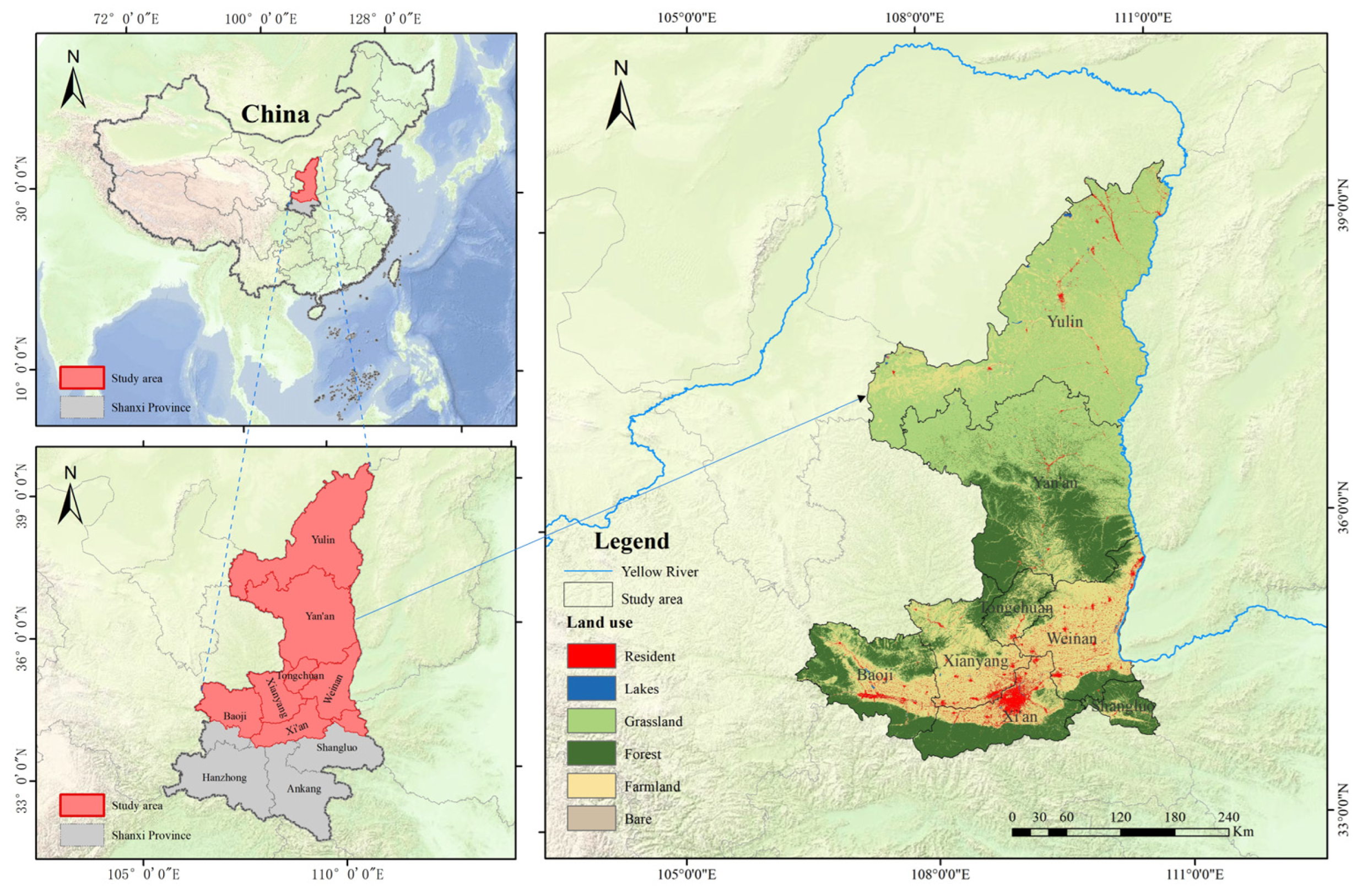
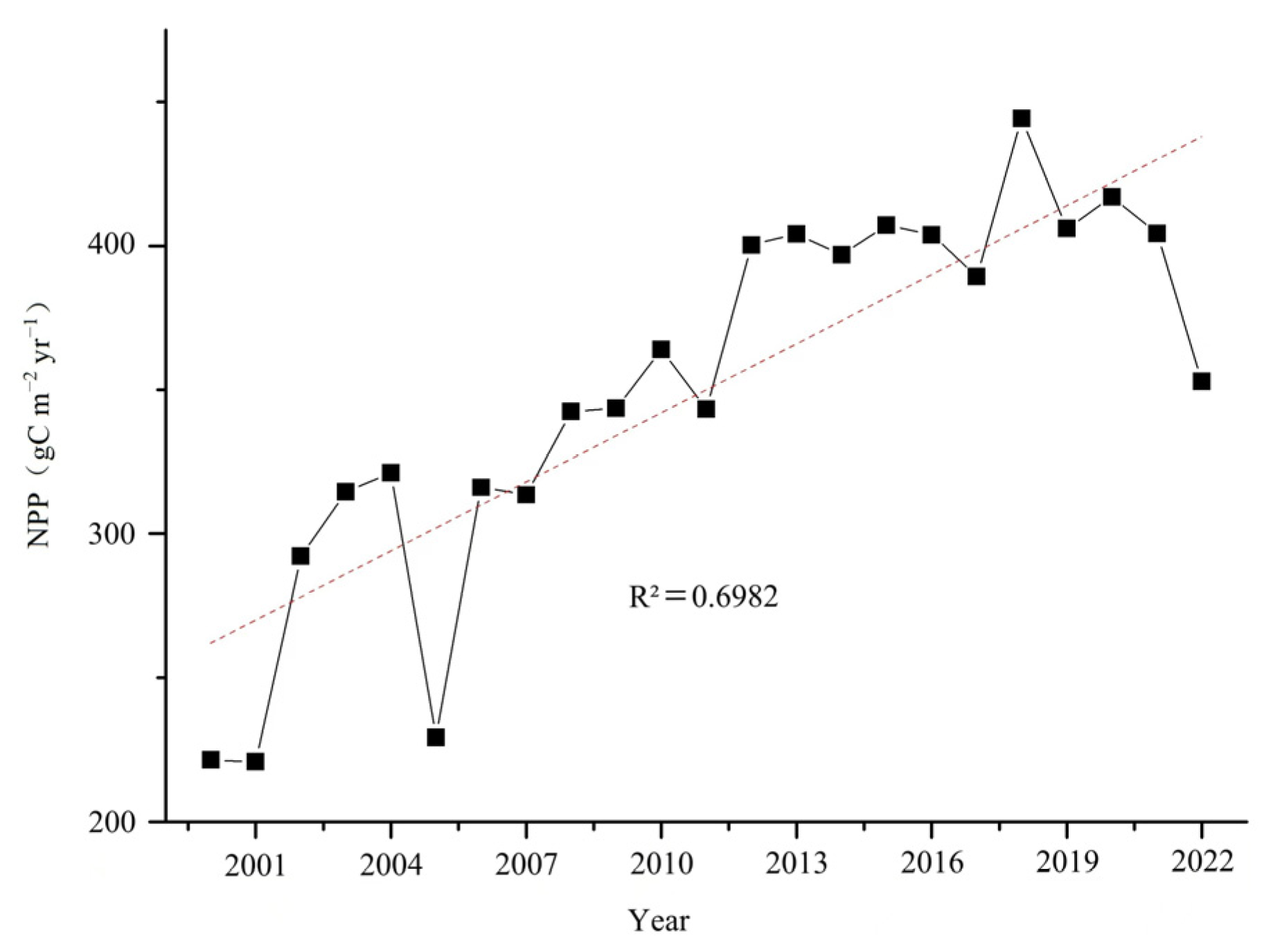
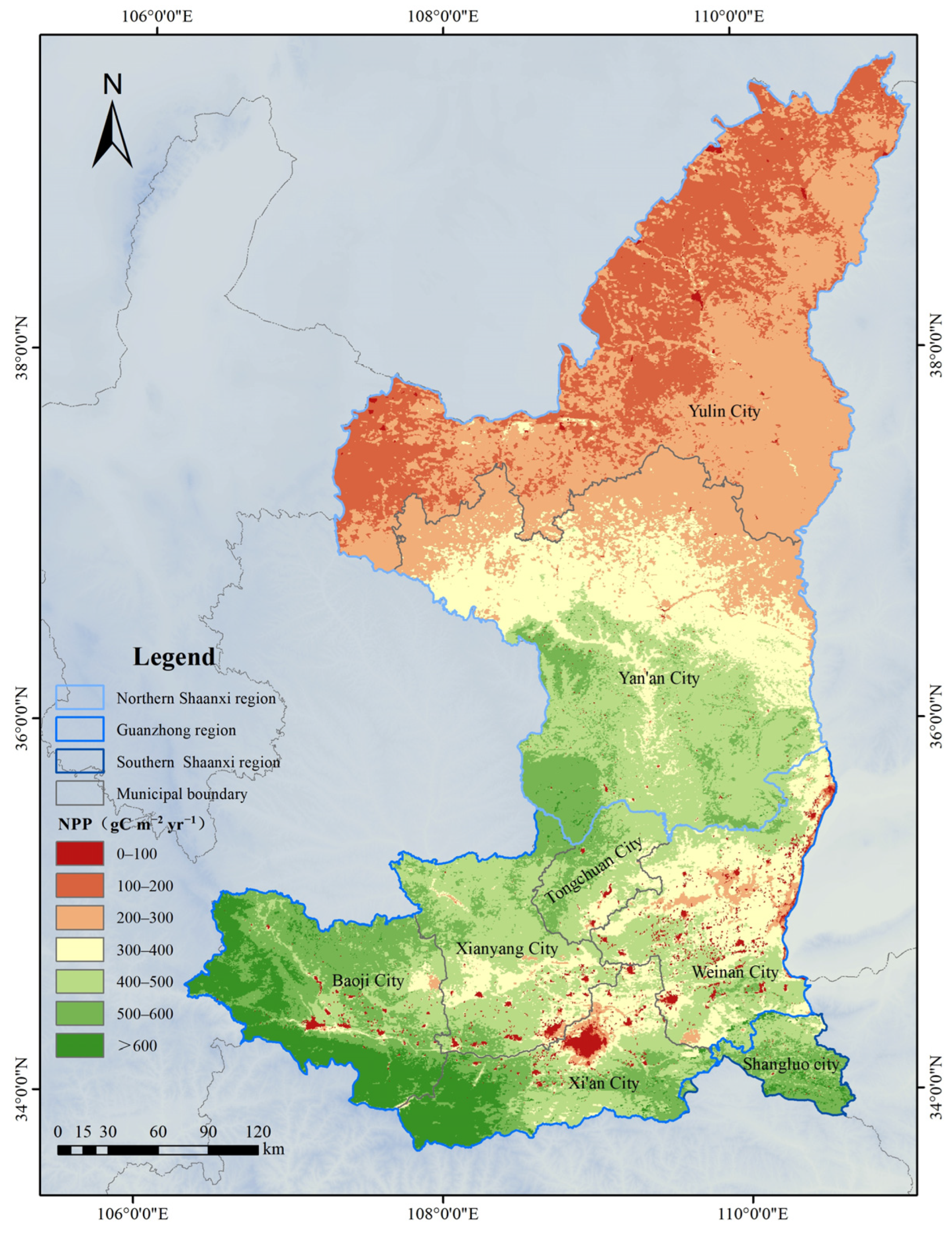
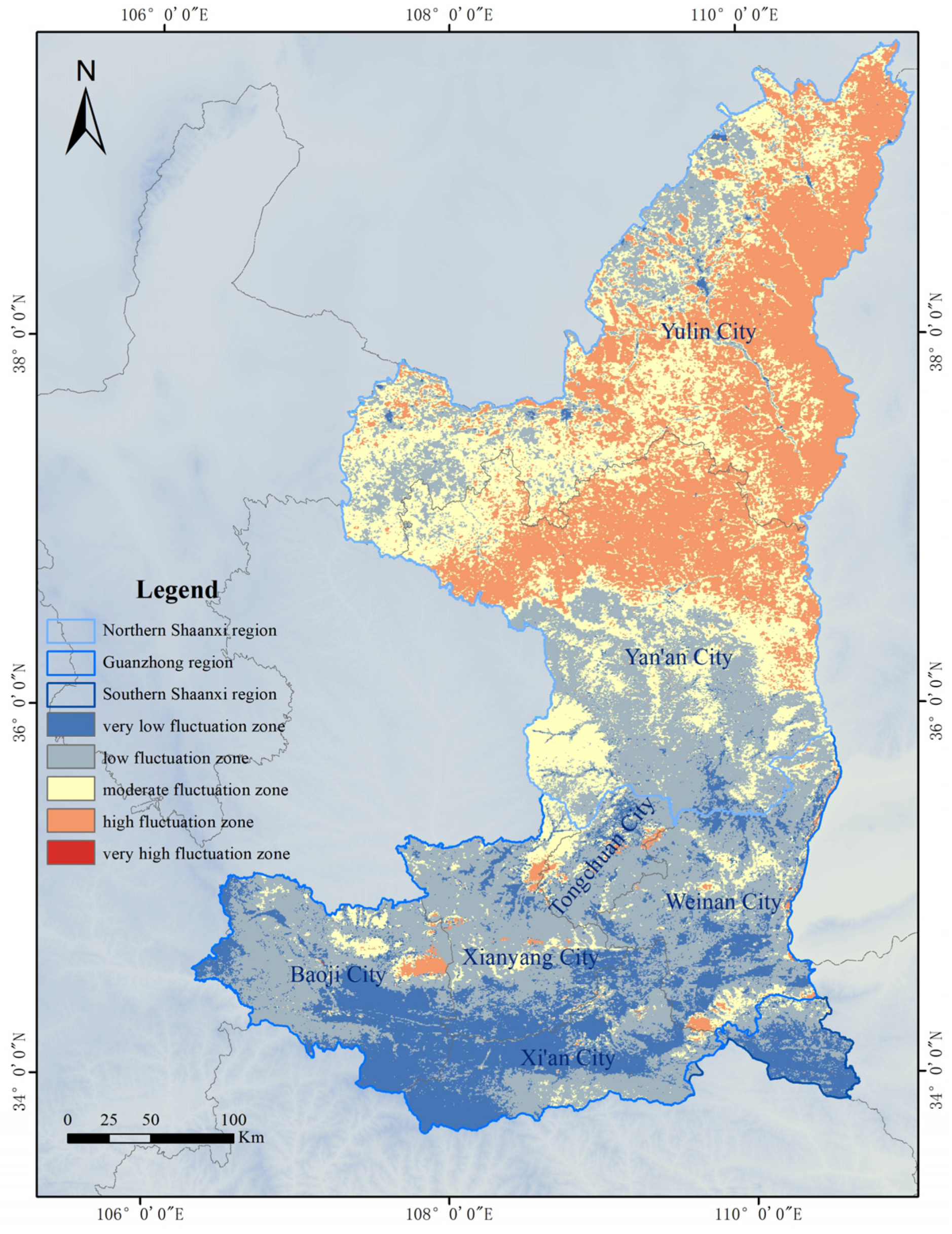
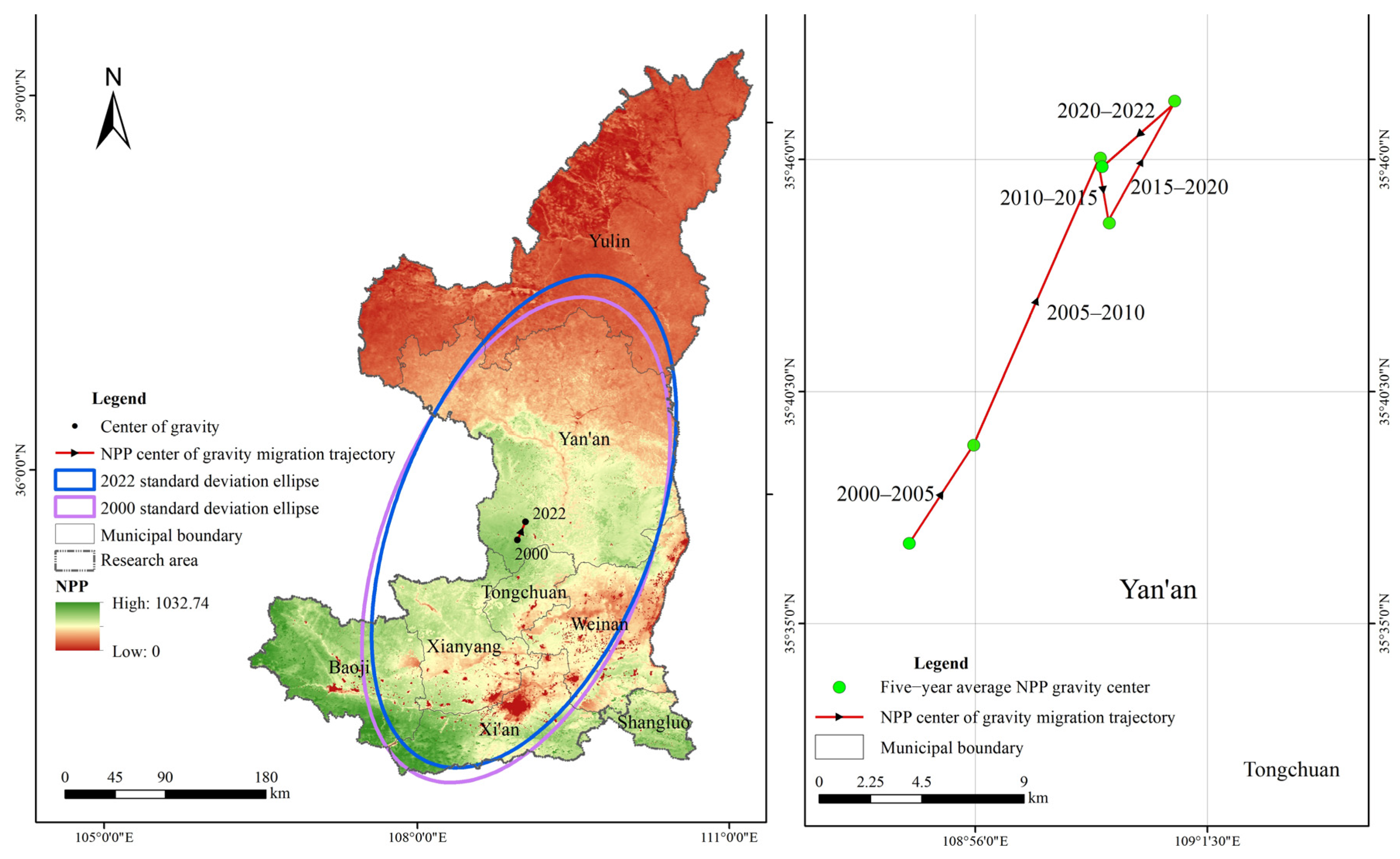
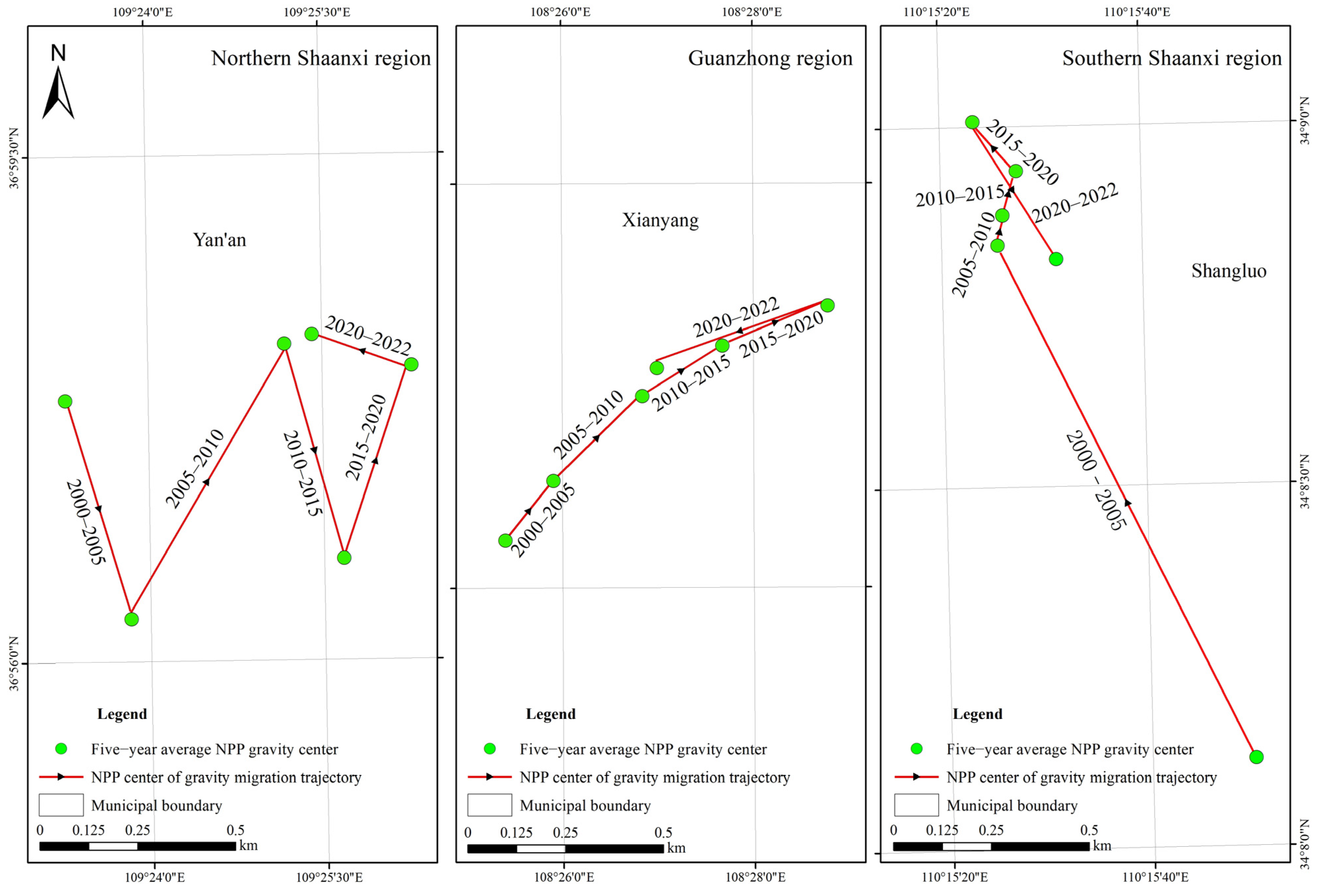


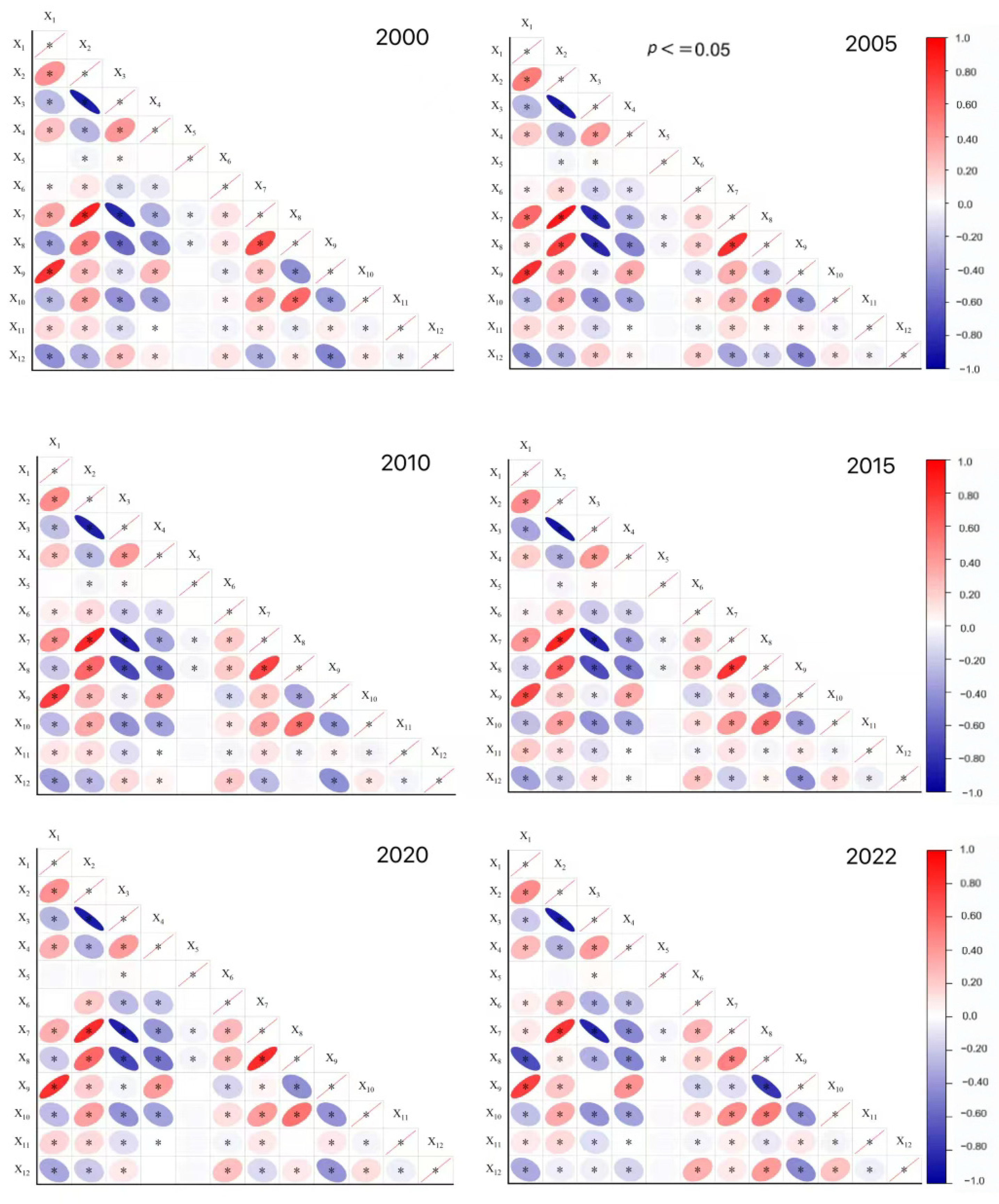
| Dataset | Indicator Factors | Data Source | Temporal Resolution | Spatial Resolution (km) |
|---|---|---|---|---|
| NPP | https://ladsweb.modaps.eosdis.nasa.gov/ (accessed on 20 March 2024) | year | 0.5 | |
| Precipitation | X1 | http://data.cma.cn/ (accessed on 18 May 2024) | month | 1 |
| Temperature | X2 | http://data.cma.cn/ (accessed on 18 May 2024) | month | 1 |
| DEM | X3 | http://www.resdc.cn/ (accessed on 18 May 2024) | - | 0.03 |
| Slope | X4 | http://www.resdc.cn/ (accessed on 18 May 2024) | - | 0.03 |
| Aspect | X5 | http://www.resdc.cn/ (accessed on 18 May 2024) | - | 0.03 |
| Nighttime light data | X6 | http://www.resdc.cn/ (accessed on 25 May 2024) | year | 1 |
| PM2.5 | X7 | https://zenodo.org/record/6398971 (accessed on 25 May 2024) | year | 1 |
| PM10 | X8 | https://zenodo.org/record/6398971 (accessed on 25 May 2024) | year | 1 |
| NDVI | X9 | https://lpdaac.usgs.gov (accessed on 20 March 2024) | year | 1 |
| 1:1,000,000 vegetation type | X10 | http://www.resdc.cn/ (accessed on 20 March 2024) | - | 1 |
| 1:1,000,000 soil type | X11 | http://www.resdc.cn/ (accessed on 25 May 2024) | year | 1 |
| Land use type | X12 | http://www.resdc.cn/ (accessed on 20 March 2024) | year | 1 |
| Driving Factors | Indicator Factors | 2000 | 2005 | 2010 | 2015 | 2020 | 2022 | 2000–2022 |
|---|---|---|---|---|---|---|---|---|
| Climatic Factors | X1 | 0.643 | 0.686 | 0.644 | 0.541 | 0.556 | 0.600 | 0.694 |
| X2 | 0.226 | 0.139 | 0.134 | 0.128 | 0.141 | 0.143 | 0.138 | |
| X7 | 0.081 | 0.119 | 0.057 | 0.154 | 0.129 | 0.234 | 0.065 | |
| X8 | 0.323 | 0.278 | 0.420 | 0.447 | 0.438 | 0.675 | 0.414 | |
| Land surface factors | X3 | 0.122 | 0.090 | 0.069 | 0.064 | 0.062 | 0.065 | 0.064 |
| X4 | 0.072 | 0.099 | 0.124 | 0.122 | 0.113 | 0.108 | 0.142 | |
| X5 | 0.001 | 0.002 | 0.002 | 0.002 | 0.003 | 0.002 | 0.003 | |
| X9 | 0.629 | 0.756 | 0.745 | 0.770 | 0.804 | 0.744 | 0.827 | |
| X10 | 0.234 | 0.332 | 0.369 | 0.366 | 0.346 | 0.324 | 0.403 | |
| X11 | 0.090 | 0.099 | 0.107 | 0.101 | 0.108 | 0.110 | 0.116 | |
| Human Activity Factors | X6 | 0.009 | 0.013 | 0.019 | 0.024 | 0.029 | 0.027 | 0.017 |
| X12 | 0.294 | 0.403 | 0.415 | 0.434 | 0.430 | 0.311 | 0.486 |
Disclaimer/Publisher’s Note: The statements, opinions and data contained in all publications are solely those of the individual author(s) and contributor(s) and not of MDPI and/or the editor(s). MDPI and/or the editor(s) disclaim responsibility for any injury to people or property resulting from any ideas, methods, instructions or products referred to in the content. |
© 2025 by the authors. Licensee MDPI, Basel, Switzerland. This article is an open access article distributed under the terms and conditions of the Creative Commons Attribution (CC BY) license (https://creativecommons.org/licenses/by/4.0/).
Share and Cite
Liu, Q.; Lyu, D.; Xie, T.; Cui, L.; Ma, Y.; Zhang, Y. Spatiotemporal Variability and Driving Factors of Vegetation Net Primary Productivity in the Yellow River Basin (Shaanxi Section) from 2000 to 2022. Atmosphere 2025, 16, 1004. https://doi.org/10.3390/atmos16091004
Liu Q, Lyu D, Xie T, Cui L, Ma Y, Zhang Y. Spatiotemporal Variability and Driving Factors of Vegetation Net Primary Productivity in the Yellow River Basin (Shaanxi Section) from 2000 to 2022. Atmosphere. 2025; 16(9):1004. https://doi.org/10.3390/atmos16091004
Chicago/Turabian StyleLiu, Qiuman, Du Lyu, Tao Xie, Lu Cui, Yifan Ma, and Yunfeng Zhang. 2025. "Spatiotemporal Variability and Driving Factors of Vegetation Net Primary Productivity in the Yellow River Basin (Shaanxi Section) from 2000 to 2022" Atmosphere 16, no. 9: 1004. https://doi.org/10.3390/atmos16091004
APA StyleLiu, Q., Lyu, D., Xie, T., Cui, L., Ma, Y., & Zhang, Y. (2025). Spatiotemporal Variability and Driving Factors of Vegetation Net Primary Productivity in the Yellow River Basin (Shaanxi Section) from 2000 to 2022. Atmosphere, 16(9), 1004. https://doi.org/10.3390/atmos16091004








